Decorating a Mountain Cabin: A Comprehensive Guide
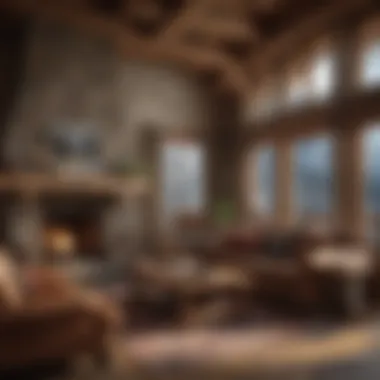
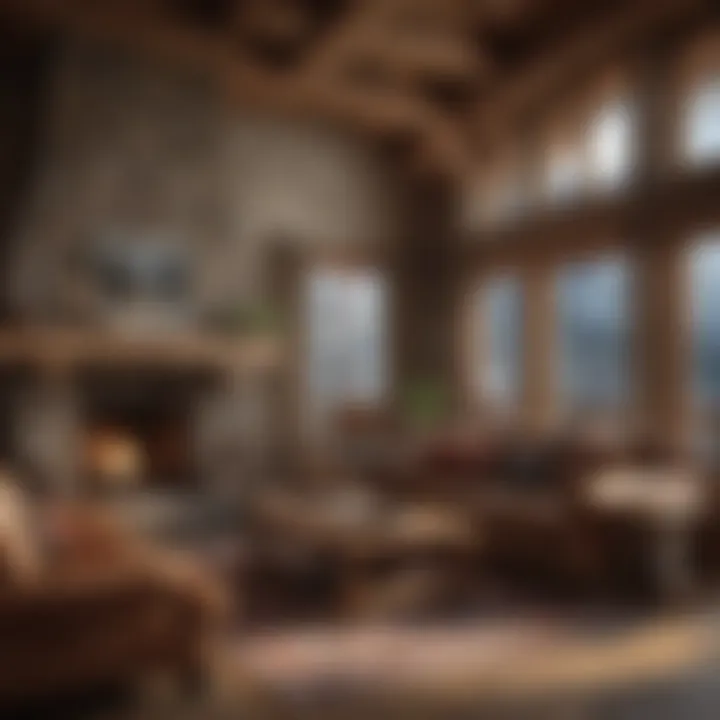
Intro
Decorating a mountain cabin requires a deep understanding of both functionality and aesthetic appeal. The aim is to create a space that feels inviting yet sophisticated, offering a perfect balance between rustic charm and modern design principles. This guide will take you through essential elements such as material selection, color schemes, and furniture choices. We also discuss the significance of sustainability and practicality in your design decisions. Through this exploration, we aim to equip homeowners and design enthusiasts with the knowledge needed to transform a mountain retreat into a beautifully cohesive living space.
Design Inspiration
Current Interior Design Trends
The trends in mountain cabin decor have shifted towards a blend of traditional and contemporary styles. Today, many decorators opt for a minimalist approach while still celebrating the intricate details that define rustic living. This involves using natural materials like reclaimed wood, stone, and linen. The emphasis on sustainability has also driven interest in ethically sourced materials.
Incorporating large windows is becoming popular. This allows for abundant natural light and breathtaking views, thereby enhancing the overall ambiance within the cabin. Open floor plans are favored as they promote a seamless flow between living areas, making them ideal for gatherings or quiet nights in.
Color Palettes and Their Effects
Choosing the right colors is crucial in establishing the desired mood within your cabin. Earthy tones, such as deep greens, browns, and muted grays, can evoke a sense of calm and connection to nature.
- Warm Colors: Reds and yellows tend to have a stimulating effect. They can be used in accents or small decor items to add warmth without overwhelming the space.
- Cool Colors: Blues and purples can create a relaxing vibe, ideal for bedrooms or quiet nooks.
In essence, color palettes should reflect the surrounding environment while offering comfort. Neutral tones can serve as a perfect backdrop for vibrant decor choices, allowing each element to stand out distinctly.
"The colors in a space not only define its character but also influence the emotions of those who inhabit it."
Entertaining Ideas
Themed Party Concepts
When entertaining guests, themed parties can add an engaging element to the occasion. Consider a rustic harvest theme that incorporates local produce into your decor and menu. This could include:
- Decor: Hay bales, mason jars filled with flowers, and burlap table runners.
- Activities: Outdoor games, such as horseshoes or cornhole.
Offering a cohesive experience encourages guests to interact and creates memorable moments.
Menu Planning and Recipes
The food served during gatherings can elevate the entire experience. Comfort food works best in a mountain setting. Think hearty dishes that resonate with the theme:
- Homemade Chili: Perfect for cold nights. Serve with cornbread for a rustic touch.
- Grilled Vegetables: Utilizing seasonal produce adds freshness.
- S’mores Station: A sweet ending campers love.
Each dish can reflect the simplicity and warmth of cabin living, fostering an environment where guests can relax and enjoy.
This guide aims to provide comprehensive insights into crafting a mountain cabin that is both functional and aesthetically pleasing, making it a true sanctuary in nature.
Understanding the Mountain Aesthetic
The mountain aesthetic is more than just a style; it embodies a strong connection to nature and an appreciation for simplicity in living. This approach to decorating a mountain cabin achieves a balance between natural beauty and functional design. Understanding this aesthetic serves as a foundational element for creating a space that is both visually appealing and practically useful. A well-thought-out design not only enhances the overall living experience but also reflects the surrounding environment, providing a tranquil retreat from the hustle and bustle of everyday life.
In this article, we will explore the historical context and key characteristics of mountain cabin design. It’s critical to recognize the influences of traditional styles that have evolved into modern interpretations. Knowing these elements helps one make informed choices about materials, colors, and layouts, ensuring that every design decision pays homage to the intrinsic beauty of the mountains.
Historical Context of Mountain Cabins
Mountain cabins have a rich history that dates back to the early settlers who sought shelter and refuge in harsh conditions. Originally, these cabins were simple structures made from local materials, primarily wood and stone. The designs often reflected practical needs rather than aesthetic considerations.
As time passed, the architectural style changed. The Arts and Crafts movement of the late 19th and early 20th centuries drew inspiration from nature, emphasizing handcrafted details and local materials. It celebrated artisanal craftsmanship, which deeply influenced the way mountain cabins were built and decorated. The significance of this history is evident today, as many modern designs still echo these traditional roots.
Understanding this historical evolution provides a framework for contemporary styles while honoring the past. It teaches us that each cabin tells a story that links the present with previous generations.
Key Characteristics of Mountain Cabin Design
Mountain cabin design exhibits several distinctive features that set it apart from other architectural styles.
- Natural Materials: Wood, stone, and metal are commonly used due to their abundance in mountainous regions. The textures of these elements help to create a warm, inviting atmosphere.
- Warm Color Palettes: Earth tones dominate the color schemes, fostering a sense of coziness and connection to nature. Colors like deep browns, greens, and neutral shades are prevalent.
- Functional Layouts: Spaces are often designed for efficiency, with open layouts that promote social interaction while also providing intimate, defined areas for relaxation.
- Integration with Nature: Large windows and open spaces invite natural light and provide views of the surrounding landscape. This connection to the outdoors is an essential element of mountain living.
"Designing a mountain cabin is about creating harmony with nature. Each choice should aim to enhance both beauty and functionality."
The key characteristics of mountain cabins create a unique living environment that embodies simplicity, warmth, and connectivity to nature. Understanding these elements enables homeowners and decorators to craft a space that truly represents the beauty of the mountain retreat.
Selecting Materials
When considering the design of a mountain cabin, the selection of materials plays a pivotal role. The materials chosen impact not only the aesthetic of the space but also its functionality and sustainability. The right materials enhance the overall atmosphere, echoing the natural surroundings while promoting comfort and durability. Several factors should be taken into account when selecting materials, including longevity, energy efficiency, and environmental impact.
Emphasizing Natural Materials
Natural materials authentically represent the rugged beauty of mountain environments. They contribute deeply to the sense of warmth and connection one desires in a cabin.
Wood
Wood is the most recognized material for cabin decoration. Its warmth, versatility, and rich texture make it a favored choice. Wood can be used for beams, walls, and flooring, establishing a cozy environment. It naturally regulates humidity and has insulating properties which enhance energy efficiency. When selecting wood, choosing species like cedar or pine is popular, as they resist decay and insects. A notable characteristic of wood is its ability to age beautifully, developing character over time. However, wood demands regular maintenance to preserve its appearance and integrity, which can be a consideration for some homeowners.
Stone
Stone brings a robust, earthy quality to cabin designs. It is commonly used in fireplaces, accent walls, and outdoor patios. The durability of stone is unmatched; it withstands both time and climate, making it a practical choice. A prominent feature of stone is its unique variations in color and texture, lending a one-of-a-kind aesthetic to each installation. While stone requires less upkeep than wood, it can be more expensive and labor-intensive to install.
Metal
Metal, particularly in the form of structural components or decorative accents, adds a modern edge to mountain cabins. Materials like steel and aluminum are increasingly popular for their strength and resistance to the elements. Their shiny, sleek surfaces provide a striking contrast to traditional wood and stone. Metal is often utilized in railings, fixtures, and frameworks, contributing an industrial vibe. Nevertheless, metal can be affected by rust and corrosion if not properly treated, necessitating more careful selection and maintenance.
Sustainable Choices
The modern cabin design must account for sustainability. Using recycled or repurposed materials is becoming essential for many designers and homeowners.
Reclaimed Wood
Reclaimed wood offers a responsible choice for cabin interiors. Sourced from old structures, this wood carries a historical richness and character that new cuts cannot replicate. It typically requires less processing, which is better for the environment. Reclaimed wood also has unique grains and colors, giving space an eclectic feel. However, the supply can be limited, and one must carefully assess quality to avoid issues related to mold or pest damage.
Low-VOC Products
Low-VOC (Volatile Organic Compounds) products are crucial to creating healthier indoor air quality. These materials release fewer pollutants and are more eco-friendly, making them a preferred choice for paints, finishes, and adhesives. Low-VOC products help maintain a healthier living environment, especially in enclosed spaces of a cabin. One of their unique features is that they often perform just as well as their traditional counterparts without compromising aesthetics. However, they may have slightly higher upfront costs, which should be weighed against their long-term benefits.
Interior Layout Considerations
In decorating a mountain cabin, interior layout plays a critical role in achieving both aesthetic appeal and functional effectiveness. The arrangement of spaces can enhance the experience of living in a mountain setting, allowing for both relaxation and practical use. The main elements to consider include natural light and the creation of functional spaces that align with your lifestyle and the cabin's environment.
Maximizing Natural Light
Natural light can transform the atmosphere of a cabin. It not only highlights the beauty of the surrounding landscape but also creates an inviting ambiance within the space. Large windows and strategically placed openings can draw in sunlight, making rooms feel more spacious and warm.
- Benefits of Natural Light
- Considerations: Proper placement of windows is vital, taking into account the sun's path and seasonal changes. Avoid facing windows directly towards harsh sunlight, as it may lead to overheating.
- Health Benefits: Access to natural light has been shown to improve mood and increase productivity.
- Energy Efficiency: By maximizing daylight, you can reduce reliance on artificial lighting, which can result in lower energy bills.
Creating Functional Spaces
Creating spaces that serve a purpose is equally important. It allows for ease of movement and ensures that each area of the cabin functions well, accommodating the needs of its inhabitants.
Open Concept
The open concept layout is characterized by fewer walls between living spaces. This design promotes a seamless flow from one area to another, which can be beneficial in a mountain cabin.
- Advantages:
- Considerations: On the downside, noise can travel easily, which may not be ideal for privacy. In addition, it requires strategic design in terms of placement of furniture to create distinct areas within the open space.
- Social Interaction: This layout encourages interaction, making it an optimal choice for gatherings.
- Visual Continuity: It can create an impression of space, which is valuable in a cabin that may have limitations on square footage.
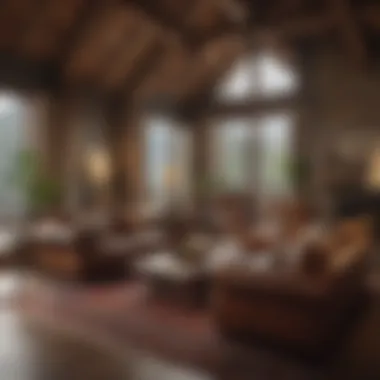
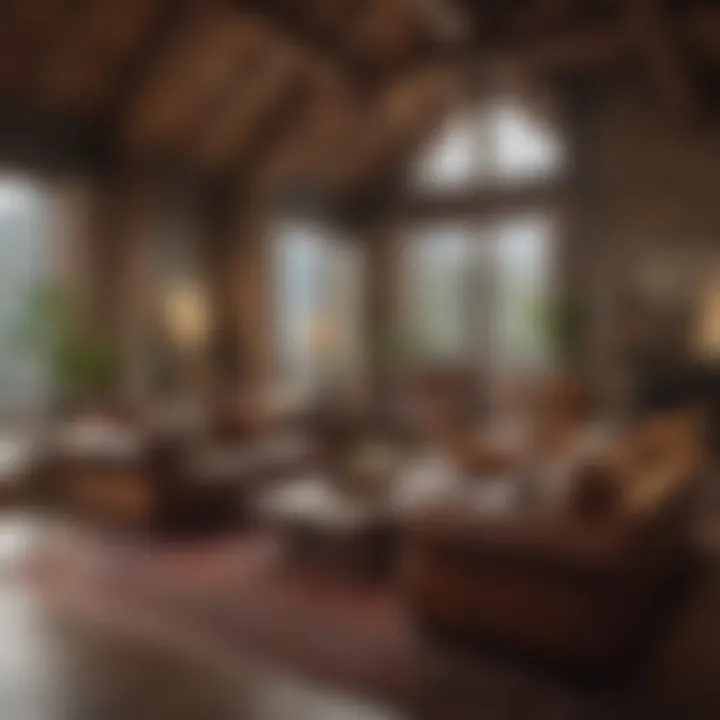
Defined Areas
On the other hand, defined areas involve separating different functions into distinct spaces. This approach can bring a sense of organization and purpose to the layout.
- Key Characteristic: Each area can be tailored to specific activities, such as dining, lounging, or working, which provides clarity and focus.
- Advantages:
- Considerations: However, it can make the cabin feel smaller and might restrict the social flow between family and guests.
- Privacy: Defined spaces allow for quieter zones, suitable for reading or working without disturbances from social areas.
- Easier Decoration: It can be simpler to design and decorate separate rooms based on their functions.
"The layout is often what determines how successful a cabin feels. Choosing between open or defined spaces should align with how you plan to use your cabin."
In summary, both interior layout strategies possess their own merits and drawbacks. Prioritizing natural light and functional spaces will contribute to a well-planned cabin design, enhancing comfort and usability.
Color Schemes and Design Themes
Color schemes and design themes are fundamental elements when decorating a mountain cabin. These aspects influence the overall atmosphere, warmth, and character of the space. Choosing the right colors can harmonize the cabin with its natural surroundings, promoting calmness and serenity. The synergy between color palettes and design themes establishes a base for furnishings, fittings, and decorative items, creating a cohesive experience throughout the cabin.
Choosing a Base Palette
Earth Tones
Earth tones play an essential role in mountain cabin decor. They consist of colors found in nature, such as browns, greens, and muted oranges. These shades evoke a sense of grounding and connection to the outdoors. The key characteristic of earth tones is their ability to blend seamlessly into a rustic environment, which makes them a popular choice.
A unique feature of earth tones is their versatility; they can create a cozy, inviting atmosphere while also providing a backdrop for brighter accent colors. Their advantages include promoting relaxation and reducing stress, as they mimic the natural world. However, using these tones excessively can lead to a dull appearance if not balanced properly with lighter or brighter colors.
Neutrals
Neutrals offer another compelling option for base palettes in mountain cabins. Colors like beige, gray, and soft whites provide a timeless appeal and can work harmoniously with various design styles. Neutrals serve as a flexible canvas, allowing other elements of decor to shine. The beneficial aspect of neutrals is their ability to create open, airy spaces, making smaller cabins feel more expansive.
These colors do not overpower the environment, maintaining a serene ambiance. A unique feature of neutrals is their compatibility with seasonal changes, adapting easily to new decor as the year progresses. However, too much neutrality can feel sterile or lifeless if personal touches are not added.
Incorporating Accent Colors
Bold Displays
Incorporating bold displays into the overall scheme can inject character and vibrancy into mountain cabins. These colors—such as deep reds, rich blues, or vibrant yellows—can create focal points and enhance visual interest. The key characteristic of bold displays is their ability to attract attention, setting a lively contrast against more muted base palettes.
Their beneficial contribution lies in energizing the space and marking specific areas, like a statement wall or accent furniture. They provide a chance for personal expression, though care must be taken to avoid overwhelming the cabin’s aesthetic with too much intensity.
Natural Hues
Natural hues, such as soft greens and light browns, evoke feelings of tranquility and comfort. These colors reflect the shades found in local landscapes, creating a soothing environment that enhances relaxation. The key characteristic of natural hues is their subtlety, offering a gentle enhancement to a room without overshadowing it.
The unique feature is their ability to forge a connection with nature while remaining versatile across various styles. These hues are generally friendly with both rustic and modern themes. However, the main disadvantage can be that they may become too subdued if there are not enough contrasting elements to bring depth and vibrancy.
"Color schemes play a pivotal role in establishing the mood and ambiance of a mountain retreat, making careful selection crucial for a harmonious living space."
Furniture Selection
Selecting suitable furniture is vital in decorating a mountain cabin. The pieces chosen not only contribute to the aesthetics but also affect the comfort and function of the space. Thoughtful furniture selection can harmonize the ruggedness of mountain living with comfort and style, creating a retreat that feels both cozy and inviting.
Comfort and Functionality
Choosing the Right Sofa
The sofa serves as the centerpiece of a living area, embodying comfort and practicality. When choosing the right sofa for a mountain cabin, one must consider durability and coziness. Look for sofas that feature sturdy, natural fabrics that can withstand both time and wear. Leather and high-quality upholstery are popular choices since they offer longevity and easy maintenance. A key characteristic of a great mountain sofa is its ability to encourage relaxation, making it suitable for lounging after a day of outdoor activities.
A unique feature to consider is a sectional sofa, which provides versatility in seating arrangements. The advantages of sectional sofas include accommodating larger gatherings and providing different configurations for varied activities. However, they can take up more space, so it is essential to balance size with room layout.
Tables and Seating
Tables and seating are critical elements in a mountain cabin's design. A solid dining table acts as the hub for meals and gatherings, while additional seating offers functionality. Vintage or reclaimed wood tables can add character and warmth, making them beneficial choices for a rustic environment. Consider width and proportion when selecting a table to ensure it fits comfortably within the space without overwhelming it.
A unique aspect of seating options is their dual purpose; for instance, ottomans can serve both as footrests and extra seating. The advantage of multipurpose furniture is that it optimizes the use of space in smaller cabins. However, striking a balance between practicality and style is crucial, as overly bulky pieces can obstruct movement and create chaos in the layout.
Shapes and Styles
Rustic vs. Modern
The debate between rustic and modern design styles is pertinent in mountain cabin decoration. Rustic styles often draw from natural elements, using wood, stone, and nature-inspired decor. This style's key characteristic is its ability to create a warm, inviting atmosphere that feels grounded in nature. The charm of rustic design makes it a popular choice for creating a truly immersive mountain experience.
Conversely, modern design emphasizes clean lines, minimalism, and functionality. This approach can provide a sleek, open feel to a cabin, contrasting traditional elements. A unique feature of combining rustic and modern styles is creating a harmonious balance that appeals to varied aesthetic sensibilities. This blend can be advantageous for cabin decorators, as it allows for personal expression while preserving the integrity of the mountain setting.
Bespoke Options
Bespoke furniture offers a tailored solution, crucial for expressing individuality in a mountain cabin. Custom pieces can be designed to fit unique spaces or complement specific design themes, ensuring that every item fulfills a purpose while contributing to the overall aesthetic. The ability to choose materials and designs makes bespoke options particularly beneficial for those looking for unique solutions.
A unique feature of bespoke furniture is its adaptability. These pieces can be designed specifically to meet the owner's preferences and requirements, making them ideal for both form and function. However, one must consider the potential disadvantages, such as higher costs and longer wait times for custom creations. Nevertheless, when crafted well, bespoke items can enhance the cabin�’s character and distinctiveness.
Decorative Accents
Decorative accents play a crucial role in enhancing the overall aesthetic of a mountain cabin. They serve as the finishing touch that ties together the various design elements throughout the home. In addition to providing visual appeal, these accents reflect personal expression and connect the cabin with its picturesque surroundings. When selected thoughtfully, they contribute to a sense of harmony and warmth, making the space inviting for both residents and guests.
Art and Craftsmanship
Local Artists
Local artists have a significant impact on the character of a mountain cabin's decor. Using works created by those who understand the cultural fabric of the region brings authenticity into the home. The key characteristic of local artists is their deep appreciation for their environment, which is often reflected in their work. This connection makes their pieces a beneficial addition to cabin decor, as they not only support the local economy but also often highlight the unique narratives of the area.
One unique feature of art from local artisans is its specialization. Many of these artists use traditional techniques that have been passed down through generations, creating items that resonate with history. For instance, a painting that depicts local landscapes can evoke a strong sense of place in a cabin. The advantages include fostering a connection to the region and celebrating its uniqueness, while a potential disadvantage could be the limited availability of such art, depending on the artist's production capacity.
Handcrafted Items
Handcrafted items often embody distinct personality and charm that mass-produced goods lack. They provide an opportunity to integrate individuality into the cabin's decor. The quality craftsmanship associated with handcrafted items makes them particularly desirable as they are usually made with great care and attention to detail. This characteristic appeals to many homeowners seeking a personal touch in their design.
One unique feature of these items is the variation in designs and textures, which can enhance the overall warmth of a space. For example, a handmade ceramic vase can introduce subtle imperfections that tell a story, in contrast to uniform factory-made pieces. The advantages are clear: each item can become a conversation starter and truly reflect the homeowner’s aesthetics. However, a drawback may include a higher cost compared to their mass-produced counterparts, which might not fit every budget.
Textiles and Patterns
Rug Selection
Choosing the right rugs is essential in a mountain cabin. Rugs add warmth and can visually anchor spaces, grounding furniture arrangements. One key characteristic of rug selection is texture. Varied textures contribute to enhancing comfort, making spaces more inviting.
Additionally, selecting rugs that fit well with the cabin's color scheme can create a cohesive look. An advantage of rugs is their ability to bring warmth, especially in colder months. However, they require maintenance, such as regular cleaning or rotation to avoid wear.
Cushions and Throws
Cushions and throws serve as important decorative accents, providing both comfort and style. This combined functionality is a key characteristic that makes them a popular choice in cabin interiors. By adding these elements, homeowners can introduce layers and depth to their space, creating a cozier atmosphere.
A unique feature of cushions and throws is the variety of patterns and fabrics available. They allow for easy seasonal updates without major renovations. An advantage of these items is that they can be used to express personal style. However, they also require regular maintenance, which can be time-consuming depending on the fabric type.
Lighting Solutions
Lighting plays a crucial role in the decoration of a mountain cabin. It enhances the overall atmosphere and can influence the practicality of the space. The combination of natural and artificial lighting greatly affects mood, usability, and aesthetic appeal. Properly integrating lighting solutions allows homeowners to adapt their cabins for various activities, emphasizing relaxation or creating a warm environment for gatherings.
Natural Lighting Strategies
Window Placement
Effective window placement is key to maximizing natural light. Placing windows strategically ensures optimal sunlight exposure throughout the day. It is particularly beneficial in mountain cabins, as it can enhance views of the surrounding landscape.
A key characteristic of well-placed windows is their ability to create a seamless connection between the indoors and outdoors. This integration is popular for its aesthetic appeal and ability to brighten living spaces.
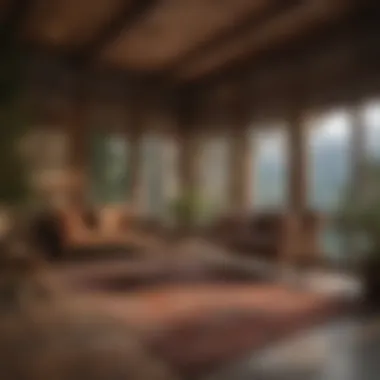
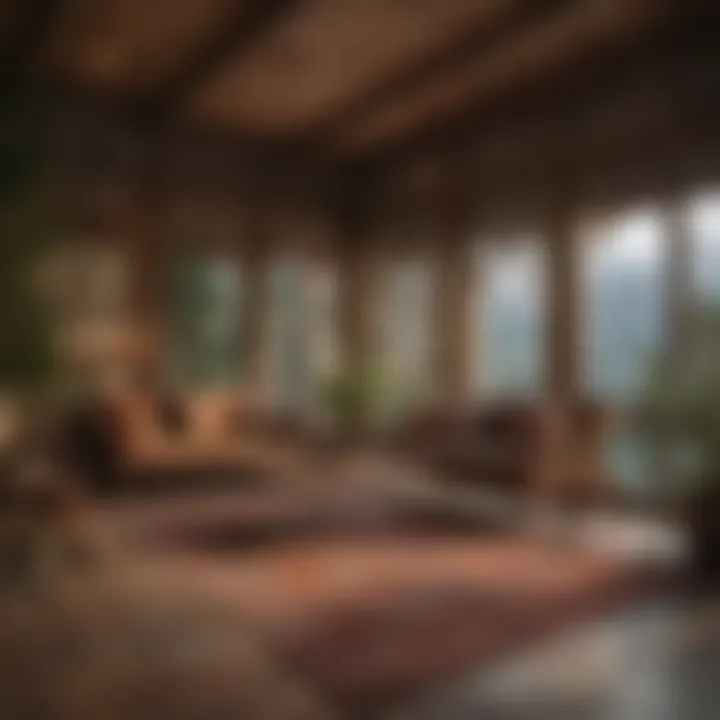
The unique feature of window placement is that it can vary based on the cabin's orientation. For instance, south-facing windows receive the most sunlight during the day, which can significantly reduce the need for artificial lighting. However, excessive sunlight can lead to heat gain and glare, which should be mitigated through shading techniques or using specialized glass.
Light Wells
Light wells serve as an innovative solution to bring natural light into deeper areas of a cabin. They are vertical shafts that channel sunlight into lower levels or interior spaces without windows.
One of the main characteristics of light wells is that they can provide natural light without compromising privacy, which can be beneficial in more secluded areas of the cabin. This makes light wells a popular choice, as they can enhance architectural interest while maintaining the cabin's cozy feel.
The unique advantage of light wells is their ability to significantly brighten spaces that might otherwise feel closed off. However, they may require careful consideration of their placement and design to ensure they do not disrupt the flow of the cabin’s layout.
Artificial Lighting Options
Artificial lighting serves a vital function in defining the ambience and usability of a cabin. When integrated thoughtfully, it can enhance both the aesthetics and functionality of a space.
Ambient Lighting
Ambient lighting is essential for establishing the overall light level in a cabin. It refers to the soft, overall light that fills a space, allowing for basic visibility and setting the mood. Its importance stems from its role in ensuring that areas are well-lit without harsh glare.
A notable characteristic of ambient lighting is its versatility. It can be achieved through various sources such as ceiling fixtures or wall-mounted lights, making it adaptable to different cabin designs. This is particularly beneficial, as it allows homeowners to create a balanced lighting scheme.
One unique feature of ambient lighting is its ability to blend seamlessly with other types of lighting, enhancing warmth and comfort. Yet, it may require additional fixtures to provide enough lighting in larger areas, which can lead to increased energy costs if not managed correctly.
Task and Accent Lighting
Task and accent lighting are crucial for enhancing specific functionalities and highlighting unique design features. Task lighting focuses on areas where activities such as reading or cooking take place, while accent lighting is used to draw attention to artworks or architectural details.
The primary characteristic of task and accent lighting is precision. These lights provide targeted illumination exactly where needed, ensuring that these areas are both functional and inviting. Their importance in a cabin cannot be overstated since they can majorly affect the practicality of spaces.
A unique aspect of task and accent lighting is the range of fixtures available, from under-cabinet lights in kitchens to spotlighting for artwork. However, utilizing too much task or accent lighting can create areas of distraction or inconsistency, making it essential to achieve balance throughout the cabin.
In summary, effective lighting strategies are fundamental for enhancing the functionality and aesthetic quality of mountain cabins. The merger of natural and artificial lighting creates an environment that is both beautiful and practical.
Functional Outdoor Spaces
Creating functional outdoor spaces is an essential aspect of decorating a mountain cabin. These spaces extend the living area outdoors, allowing residents to connect with nature while enjoying the comforts of home. Considerations for layouts, materials, and overall design contribute significantly to the effectiveness of these areas.
Outdoor spaces can include patios, decks, and gardens, each serving different purposes but working harmoniously together. The benefits of well-designed outdoor areas include enhanced aesthetics, increased property value, and expanded opportunities for relaxation and entertainment. Moreover, embracing the natural setting through thoughtful design can create a seamless transition between indoor and outdoor environments.
Designing Patios and Decks
When designing patios and decks, the key is to ensure functionality, accessibility, and comfort. These structures should complement the cabin's architecture while providing usable space for family gatherings, social events, or quiet retreat.
Selecting appropriate materials is crucial. Natural stone or treated wood often blends well with the mountain aesthetic and withstands the elements. Consider integrating built-in seating or fire pits, which can enhance usability year-round. The layout should prioritize flow, broad areas for movement, and cozy nooks for conversation.
Incorporating Landscaping
Landscaping plays a pivotal role in shaping the outdoor environment. It creates inviting spaces, aids in privacy, and can contribute to ecological sustainability.
Native Plants
Native plants particularly benefit outdoor spaces. These species are naturally adapted to the local climate and soil, requiring less maintenance and water. Moreover, they provide habitats for local wildlife, contributing positively to the ecosystem. Incorporating native plants also fosters a sense of place, connecting the cabin to its natural surroundings.
Some key characteristics of native plants include:
- Drought resilience: They withstand dry conditions, reducing the need for irrigation.
- Biodiversity: Attract various pollinators, enhancing ecological health.
However, be mindful of potential disadvantages, such as limited flowering seasons compared to exotic varieties. Nonetheless, their overall long-term benefits often outweigh these concerns.
Hardscaping Elements
Hardscaping elements add structure and functionality to outdoor spaces. They include patios, pathways, walls, and other non-plant features that serve practical purposes. Hardscaping enhances the durability of outdoor areas, providing safe and accessible travel routes.Incorporating materials like gravel, pavers, or wood can harmonize with the mountain ambience. The selection of robust materials ensures longevity and easy maintenance.
Some advantages of hardscaping elements are:
- Defined spaces: Clearly mark different areas for various uses, such as dining or lounging.
- Erosion control: Help stabilize soil, reducing runoff and erosion on sloped terrains.
There are considerations, too; hardscaping can become overwhelmed by invasive plant species if not implemented carefully. A thoughtful balance of plants and hardscaping will create a cohesive outdoor environment that fits the mountain cabin aesthetic.
Seasonal Decor
In the realm of mountain cabin decorating, the significance of seasonal decor cannot be overstated. It adds vibrancy and an element of warmth to the living space, reflecting the changes in nature and enhancing the overall ambiance. Seasonal decor is not just about aesthetics; it fosters a connection between the inhabitants and the surrounding environment. This guide will delve into essential components, benefits, and considerations regarding seasonal decor, focusing on how to seamlessly transition your cabin’s atmosphere throughout the year.
Adapting to Seasons
Winter Accents
Winter accents play a pivotal role in creating a cozy atmosphere within a mountain cabin during the colder months. One of their main characteristics is their ability to evoke warmth and comfort, essential qualities when the temperatures drop outside. Popular elements include plush blankets, soft area rugs, and even decorative snowflakes or frosty motifs. The addition of these winter-themed items not only enhances the visual appeal of the cabin but also emphasizes a welcoming experience for everyone who enters.
Unique features of winter accents often include textured fabrics and rich colors that align with the season. For instance, deep reds and forest greens from materials like wool and flannel can contrast beautifully with the snowy landscape outside. This feature contributes to creating a feeling of unity with the surrounding environment, as the interior decor mimics the seasonal changes witnessed outside.
However, it is crucial to maintain balance. Overdoing winter decorations can lead to an overwhelming visual experience. Therefore, homeowners should carefully curate their winter accents, ensuring they align with the overall cabin style and do not compromise the space's functionality.
Summer Touches
Conversely, summer touches introduce a refreshing and lively mood to the cabin. Decorating for summer is all about embracing lightness and brightness. Incorporating elements like brightly colored cushions, lightweight throws, and natural fibers allows for an effortless transition from the warmth of winter to the inviting glow of summer. These accents not only uplift the spirit but also echo the vibrant colors found in nature during this season, such as lush greens and cheerful blooms.
A unique feature of summer touches involves the use of outdoor-themed decor, such as floral arrangements or seashells. These items can easily transition from indoor to outdoor settings, enhancing the enjoyment of the beautiful summer days. They invite a celebratory tone and encourage activities that bring family and friends together in the outdoor spaces surrounding the cabin.
Nonetheless, while summer touches can bring brightness, one must be judicious in selection. Too many vibrant elements might clash or lead to visual chaos. Simplicity is key, allowing for effortless enjoyment of both the decor and the stunning summer landscapes.
Thematic Decorations
Thematic decorations are another vital aspect of seasonal decor. They allow homeowners to celebrate different aspects of their lives, from holidays to local culture, through thoughtful design choices.
Holidays
Decorating for holidays serves as a wonderful method to foster a sense of belonging and celebration within the cabin space. Integrating holiday decorations brings an instinctive warmth and joy. They highlight the spirit of togetherness, encouraging family gatherings and friend visits. One notable characteristic of holiday decor is its versatility. Whether it is Christmas lights, fall leaves, or Thanksgiving centerpieces, thematic decorations can easily adapt to fit the season and personal preferences.
Unique features of holiday decorations include their ability to tell a story; they can evoke cherished memories and traditions passed down through generations. Though beautiful, a potential downside is the time and effort needed to switch decorations regularly, which may disrupt other design elements in the cabin.
Local Culture
Engaging with local culture through decor creates a unique identity for your mountain cabin. Incorporating regional art pieces, textiles, and traditional crafts highlights the richness of the area. This approach also communicates respect and appreciation for the local community, making it an enriching design choice.
The key characteristic of local culture decor lies in its authenticity. Items sourced from local artisans not only enhance the cabin's aesthetic but also provide a sense of narrative behind each piece. However, sourcing these items requires careful consideration of quality and authenticity over mere novelty, which can sometimes lead to less genuine representations.
Ultimately, balancing these decorative aspects can turn any mountain cabin into a personal retreat reflecting the changing seasons and local nuances while providing warmth and unity with its environment. Emphasizing seasonal decor enriches the living experience, crafting a welcoming retreat for years to come.
Technology Integration
The integration of technology in decorating a mountain cabin serves multiple purposes. It enhances comfort, security, and entertainment, creating a more enjoyable and practical living environment. As cabins often attract visitors seeking relaxation, technology must blend seamlessly with the rustic charm while providing modern amenities. This balance is crucial for homeowners who wish to maintain an authentic atmosphere without sacrificing convenience or efficiency.
Smart Home Features
Climate Control
Climate control is essential for maintaining a comfortable environment in mountain cabins, where temperatures can fluctuate dramatically. Advanced climate control systems, such as smart thermostats, allow homeowners to adjust heating or cooling remotely via smartphones. This connectivity is a major point of attraction, as it supports both comfort and energy efficiency.
One significant advantage of such systems is their ability to learn user preferences. Over time, smart thermostats adapt to your schedule, optimizing energy use while keeping the cabin cozy. However, initial setup can require some technical know-how, and integration with existing systems may pose challenges for some cabin owners.
Security Systems
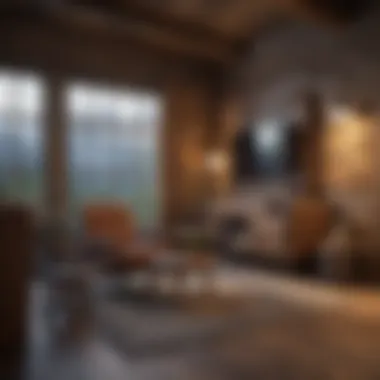
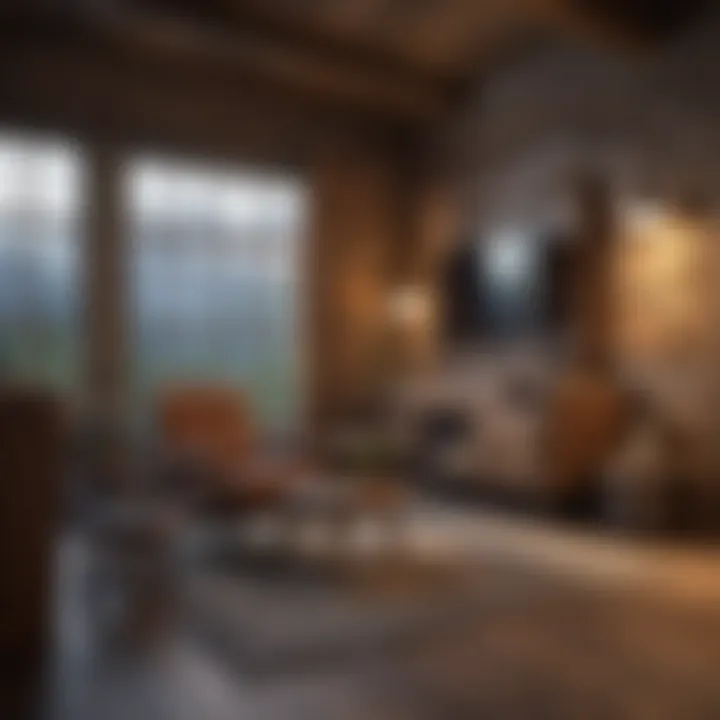
Security systems are vital for ensuring peace of mind, particularly for those who may not reside in their cabins year-round. A comprehensive security system can include camera surveillance, motion detectors, and alarm settings, all controlled via smartphone apps. The key characteristic of these systems is their ability to provide real-time monitoring, keeping homeowners informed about the safety of their property.
Additionally, many modern security solutions offer automation features, such as scheduled alerts or notifications. Nevertheless, one must consider the potential for false alarms, which can lead to unnecessary concerns or disturbances. Overall, investing in a reliable security system ensures the safety of both property and its occupants.
Audio and Visual Systems
Sound Solutions
Sound solutions enhance the ambiance of a cabin, promoting a richer audio experience. Many homeowners opt for wireless sound systems that can seamlessly integrate with existing décor. These systems allow for easy playback of music or audio from various devices, contributing to a welcoming atmosphere.
The distinctive feature of sound solutions is their versatility; they can be adapted for outdoor spaces or different rooms within the cabin. However, when selecting a system, consider the acoustics of the space. Some systems may require additional tuning to achieve optimal sound quality, underscoring the importance of understanding your cabin's layout.
Media Setup
Media setup is another important aspect of technology integration in mountain cabins. This can include everything from televisions to entertainment hubs that link various devices. A well-planned media setup provides both entertainment for guests and a means to keep connected with the outside world.
The key benefit of an organized media setup is its ability to consolidate controls for various devices into one user-friendly interface. On the downside, there might be a learning curve associated with installing and using these systems, particularly for less tech-savvy individuals. A good approach would be to gather all the necessary equipment before starting the setup, ensuring a smoother installation process.
Budgeting for Your Project
Budgeting holds a significant role in the journey of decorating a mountain cabin. It lays the foundation for all subsequent decisions regarding materials, furniture, and even labor costs. Without a clear budget, one may find it easy to overspend or make choices that do not align with overall vision. A well-thought-out budget helps in prioritizing elements that are essential while allowing for flexibility in areas that may be less critical. Understanding how to allocate funds wisely can transform your cabin into an inviting space without breaking the bank.
Establishing a Design Budget
The first step in effective budgeting is establishing a design budget. This requires an honest assessment of how much you are willing to spend. Consider all potential costs, including materials, furnishings, and any subcontractor services you might need. It's advisable to also allocate funds for unexpected expenses, which often occur during a renovation or decoration project. Some experts recommend adding around 10-15% to your budget for contingencies. This will provide a buffer for items such as damage to materials or price increases for services.
Allocating Funds for Different Areas
Allocating funds wisely is crucial for achieving a balanced and appealing cabin. It is essential to recognize that not all aspects of the project require equal investment.
Furniture vs. Decor
When discussing Furniture vs. Decor, it’s vital to know how each contributes to your cabin’s atmosphere. Furniture serves a functional purpose; it provides seating, storage, and surfaces for daily use. Well-chosen furniture can dictate the flow and usability of the cabin. On the other hand, decor adds personality and warmth to the space. Choosing to invest more in high-quality, versatile furniture can lead to long-term satisfaction, while decor can often be changed or updated seasonally without substantial financial impact. In this way, opting for a balanced approach ensures both functionality and aesthetic appeal are met without exceeding budget constraints.
Labor Costs
Labor Costs represent another important area of consideration. Hiring professionals can elevate the quality of your cabin’s design. However, these costs can quickly add up. It’s beneficial to understand what tasks a professional should handle versus what can be managed as a DIY project. For instance, complex installations, like electrical work, should always be handled by a licensed contractor. This choice safeguards against future issues. However, simpler tasks like painting or landscaping can be tackled in a DIY manner, saving money while still allowing for a personal touch.
In the budgeting stage of your mountain cabin project, clarity and foresight aid in creating a beautiful and functional environment. Emphasizing thoughtful allocations for both furniture and labor ensures that your cabin can evolve into a stylish retreat without overstepping financial boundaries.
Hiring Professionals vs. DIY
When considering how to decorate your mountain cabin, homeowners often face a decision between hiring professionals or embarking on a DIY journey. This decision is pivotal because it impacts not only the aesthetic outcome but also the overall enjoyment of the space, the budget, and the time invested. Each approach has distinct advantages and considerations.
When to Hire Experts
Engaging professionals should be contemplated when the project scope is extensive or if specific expertise is required. Hiring designers or contractors can save time, ensure quality, and deliver a style that aligns seamlessly with your vision. Professionals bring experience in using materials, balancing light, and understanding of spatial design that a novice might overlook. They also can access resources that are unavailable to the average consumer and may provide insights about local building codes or best practices.
However, while professional help can elevate the project significantly, it often comes with higher costs. It is essential to weigh the investment against what you hope to achieve. If you desire a cohesive look or complex renovations, hiring experts is a sound choice.
Successful DIY Projects
Planning and Design
Planning and design are critical in ensuring a successful DIY project. This phase encompasses setting priorities, establishing a budget, and researching styles that reflect your personality. It serves as a roadmap, guiding you through choices on color palettes, furniture arrangements, and materials. An effective plan helps you visualize the end result, which can minimize mistakes and wasted resources.
The key characteristic of effective planning is the ability to foresee the desired outcomes and methodology. This step is beneficial because it allows for organization and saves time. It encourages the anticipation of challenges and promotes more informed purchasing decisions. A thoughtful design plan enables you to maintain focus and clarity throughout the decoration process.
However, a unique feature of planning is that it often requires flexibility; decisions may change as the project progresses. This adaptability can be both an advantage and disadvantage. While it allows for creative evolution, it can also lead to indecision or increased costs if not managed well.
Execution Tips
Execution tips are essential steps that help translate your planning into reality. They cover practical measures, such as measuring spaces accurately, using the right tools, and maintaining safety standards. The primary focus should revolve around methodical execution: working one area at a time and ensuring that tasks are completed thoroughly before moving on.
The characteristic of strong execution is attention to detail. Each element, from assembling furniture to hanging artwork, should receive conscientious effort. This meticulous approach guarantees that the final result reflects the vision accurately.
Additionally, a unique feature of good execution is its reliance on patience and careful timing. Rushing through can lead to mistakes, affecting the end project quality. Devoting appropriate time to each task helps ensure that you end up with a well-decorated space that resonates with your efforts.
Remember: "The difference between a dream and a reality is the effort put into making it happen."
It is crucial to consider whether to activate personal skills or rely on expert help when decorating your mountain cabin. The right choice can significantly shape your experience and the environment in your home.
Maintenance of Your Cabin
Maintaining a mountain cabin is a critical aspect of ensuring its longevity and comfort. The rugged environment can cause wear and tear that, if neglected, can lead to significant damage. Regular maintenance increases the lifespan of your materials, keeps aesthetic appeal, and ensures safety for inhabitants. Emphasizing maintenance also showcases responsible ownership and respect for nature.
Regular Upkeep
Cleaning Protocols
Cleaning your cabin regularly is essential for several reasons. It prevents buildup of dirt and moisture, which can lead to mold or pest problems. Quite often, the cleaning routines might include dusting surfaces, vacuuming rugs, and wiping down windows. One key characteristic of cleaning protocols is the emphasis on using suitable equipment and products that won’t damage either the structure or the environment.
Cleaning protocols are a beneficial choice, especially in terms of health. A clean cabin ensures fresh air circulation and keeps allergens at bay. However, it is important to avoid harsh chemicals that can be detrimental to both health and the surrounding nature.
The unique feature of cleaning protocols is their adaptability. Depending on the season, different cleaning tasks may be prioritized. For example, removing snow from entrances in winter or cleaning the outdoor furniture in summer makes for manageable tasks throughout the year.
Seasonal Checks
Seasonal checks are crucial in monitoring the overall condition of the cabin. They contribute to proactive maintenance, allowing homeowners to catch issues before they escalate. Regular inspections help identify problems such as leaks, wear on roofing, and any pest infestations. One key characteristic of seasonal checks is their comprehensive nature, covering various aspects including plumbing, heating, and structural integrity.
These checks serve as a beneficial choice as they help maintain the cabin’s value. Ignoring small issues often leads to costly repairs. The unique feature of seasonal checks lies in their systematic approach; assessments are conducted according to seasonal changes, ensuring every part of the cabin is appropriately maintained.
Sustainability in Maintenance
Sustainability must play a role in cabin maintenance as it promotes environmental responsibility. Thoughtful choices can contribute to a sustainable living environment without sacrificing quality.
Eco-Friendly Products
Using eco-friendly products for cleaning and maintenance is increasingly popular amongst cabin owners. These products minimize environmental impact. They often contain natural ingredients that pose little risk to the environment yet still ensure effective maintenance. This characteristic makes eco-friendly products an excellent choice for maintaining balance between cleanliness and sustainability.
The unique feature of these products is their safety. Many eco-friendly products do not release harmful chemicals, which is beneficial not only for the environment but also for the inhabitants. While they may come at a higher price point, the long-term health benefits often outweigh the initial costs.
Long-Lasting Materials
Long-lasting materials refer to materials that endure the test of time and weather conditions. Choosing these materials can significantly decrease the frequency of necessary repairs, making them a sound investment. Their durability is a key characteristic that adds value to the cabin.
Selecting long-lasting materials is beneficial because it reduces waste. Fewer replacements mean a smaller ecological footprint over time. The unique feature of these materials is their ability to blend beauty with function. Their timeless appeal often means they complement the rustic theme of a mountain cabin while ensuring high performance.
Regular maintenance is not just about keeping a cabin clean; it's about preserving the integrity of your investment and the natural beauty that surrounds it.
Ending: The Art of Cabin Decorating
Decorating a mountain cabin is an endeavor that combines aesthetics with functionality. This article has illustrated the importance of integrating various design principles to create spaces that are both appealing and comfortable. Ultimately, the conclusion reflects on how design elements work in harmony to produce a distinctive atmosphere that captures the essence of mountain living.
Summarizing Key Design Principles
In summary, effective cabin decorating relies on a myriad of design principles. Key among these is the emphasis on natural materials, which resonate well with the mountain environment. As discussed, elements like wood, stone, and metal not only withstand the test of time but also enhance the overall rustic appeal.
A coherent color scheme is also vital. Earth tones often work best in mountain cabins, establishing a calming environment that reflects the surrounding landscape. Accent colors, when used sparingly, can elevate the aesthetic without overwhelming the senses.
Functional spaces should be a priority. An open concept layout invites natural light, while defined areas provide necessary boundaries. Every piece of furniture must serve a purpose without cluttering the area. This balance of comfort and elegance is the hallmark of a well-decorated cabin.
Embracing Personal Expression
Personal expression is crucial in cabin decorating. It allows homeowners to infuse their unique tastes into the design. Integrating handcrafted items or artwork from local artists can significantly personalize the space. By doing this, a homeowner transforms their cabin into a reflection of their experiences and values.
Using textiles to express style is equally important. Items like cushions, throws, and rugs can introduce texture and color, enhancing the overall experience without compromising on comfort. Environmentally friendly choices, such as sustainable textiles, not only support the planet but also connect the cabin to its natural surroundings.
Ultimately, cabin decorating is more than just an aesthetic task; it is about creating a space that one feels connected to and represents both comfort and individual identity. The art lies in finding the balance between rustic charm and modern sensibilities, ensuring that every decision reflects a thoughtful design philosophy.















